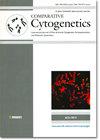Cell新南威尔士州中部海岸Pseudophryne coriacea (Keferstein, 1868) (Amphibia, Anura)的培养和核型描述
IF 0.9
4区 生物学
Q4 GENETICS & HEREDITY
引用次数: 0
摘要
来自新南威尔士州中部海岸的IUCN最不关注的红背小蟾蜍Pseudophryne (P.) coriacea (Keferstein, 1868)的核型是在剪趾浸渍菌组织培养和常规DAPI染色后描述的。二倍体数为2n = 24。核型由6对大染色体和5对小染色体和1对很小的染色体组成。非常小的12号染色体只有1号染色体的12%大小。其中一条大的染色体是亚远心的,两条大的染色体是亚常心的,其余的染色体是常心的。在4号染色体上观察到假定的核仁组织区(NOR)。假定的NOR的二倍体数量和位置与先前发表的IUCN极度濒危的corroboree (Moore 1953)和未发表的corroboree核型描述相关。这是1843年首次报道的假葡萄属(Pseudophryne Fitzinger)物种的细胞培养,也是首次发表的对假葡萄属(Pseudophryne Fitzinger)核型的分析,以及首次发表的对该属着丝粒分配的分析。在全球范围内,冷冻银行中存在大量与已知恢复机制(如基本细胞培养技术)无关的组织样本。因此,不可能对这些冷冻样本进行详细的细胞遗传学分析。因此,这项工作能够:(i)将马齿苋核型与极度濒危的马齿苋核型进行比较,(ii)为重复和未来对该属冷冻样本进行细胞遗传学和基因组分析提供基准。本文章由计算机程序翻译,如有差异,请以英文原文为准。
Cell culture and karyotypic description of Pseudophryne coriacea (Keferstein, 1868) (Amphibia, Anura) from the New South Wales Central Coast
Abstract The karyotype of the IUCN least concern red-backed toadlet Pseudophryne (P.) coriacea (Keferstein, 1868) from the New South Wales Central Coast is described following tissue culture of toe clipping macerates and conventional DAPI staining. The diploid number is 2n = 24. The karyotype is represented by six large and five small chromosomal pairs and one very small chromosomal pair. The very small chromosome 12 is 12% the size of chromosome 1. One of the large chromosomes is subtelocentric, two of the large chromosomes are submetacentric and the remaining chromosomes are metacentric. The putative nucleolus organiser region (NOR) is observed on chromosome 4. The diploid number and location of the putative NOR correlates to that of the previously published IUCN critically endangered P.corroboree (Moore 1953) and unpublished descriptions of the P.coriacea karyotype. This is the first described cell culture of a species from the genus Pseudophryne Fitzinger, 1843, first published analysis of the P.coriacea karyotype and the first published analysis of centromeric allocation of this genus. Globally there exists a large inventory of tissue samples in cryobanks that are not associated with known recovery mechanisms such as basic cell culture techniques. Detailed cytogenetic analyses of these cryobanked samples are therefore not possible. This work therefore enables: (i) a comparison of the P.coriacea karyotype with that of the critically endangered P.corroboree and (ii) a benchmark for repeat and future cytogenetic and genomic analyses of cryostored samples of this genus.
求助全文
通过发布文献求助,成功后即可免费获取论文全文。
去求助
来源期刊

Comparative Cytogenetics
生物-遗传学
CiteScore
2.40
自引率
0.00%
发文量
13
审稿时长
>12 weeks
期刊介绍:
Comparative Cytogenetics is a peer-reviewed, open-access, rapid online journal launched to accelerate research on all aspects of plant and animal cytogenetics, karyosystematics, and molecular systematics.
All published papers can be freely copied, downloaded, printed and distributed at no charge for the reader. Authors are thus encouraged to post the pdf files of published papers on their homepages or elsewhere to expedite distribution. There is no charge for color.
 求助内容:
求助内容: 应助结果提醒方式:
应助结果提醒方式:


